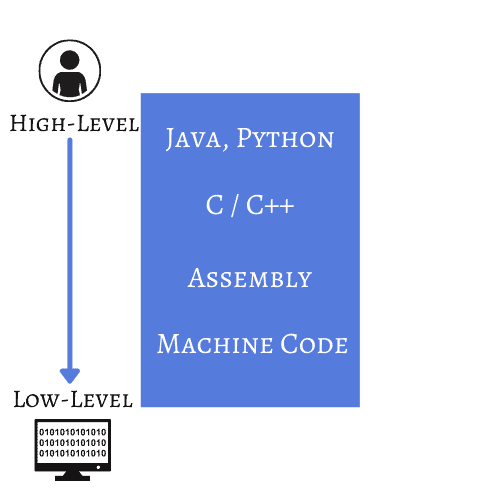1. 引言
你有没有想过,我们写的代码是如何被计算机理解的?比如,我们能不能直接用 0 和 1 来编程?毕竟计算机底层就是靠这些二进制数字运行的。
这个问题的答案,其实和编程语言的抽象层级有关。
在本文中,我们会深入讲解高级语言与低级语言之间的区别。 最终,你将能够清晰地理解它们各自的优势和适用场景,并明白为什么这两类语言都如此重要。
2. 抽象层级概述
编程语言可以根据其抽象程度进行分类。虽然这个分类是相对的,但核心思想是:
语言越接近人类语言,就越高级;越接近机器能理解的二进制指令,就越低级。

2.1. 低级语言(Low-Level)
低级语言的抽象程度非常低,代码难以直接阅读和理解,而且不具备可移植性。要使用这类语言编程,通常需要对目标平台有深入了解,并具备一定的编程经验。
使用低级语言的主要优势是:你可以精确控制硬件行为。
当你对性能有极高要求、需要极致优化,或者运行环境资源极其有限时(比如嵌入式系统),低级语言通常是首选。
低级语言主要包括:
- 机器码(Machine Code):由 0 和 1 构成的二进制代码,是计算机唯一能直接执行的指令。
- 汇编语言(Assembly):虽然仍远离人类语言,但通过助记符(如
MOV,ADD)提高了可读性。需要通过汇编器(assembler)转换为机器码。
✅ 优势:极致控制、性能优化
❌ 劣势:开发效率低、可维护性差、不可移植
2.2. 高级语言(High-Level)
高级语言的设计目标是让程序员更容易理解和使用。它们通常使用接近自然语言的语法和结构,比如 Java、Python、C# 等。
使用高级语言的最大优势是:开发效率高,代码可读性强,适合快速开发复杂系统。
当然,高级语言最终也需要通过编译或解释转换为机器码才能运行。不同的语言使用不同的方式,比如:
- 编译型语言(如 C、C++):一次性编译为机器码
- 解释型语言(如 Python、JavaScript):运行时逐行解释执行
✅ 优势:开发效率高、跨平台、生态系统丰富
❌ 劣势:性能不如低级语言、抽象层高可能导致资源浪费
3. 示例对比
为了更直观地展示高级语言和低级语言之间的差异,我们来看一个计算两个数平均值并输出结果的简单程序。
3.1 高级语言(C语言)
#include <stdio.h>
int main()
{
int num1, num2;
float avg;
num1 = 2;
num2 = 8;
avg= (float)(num1+num2)/2;
printf("Average of %d and %d is: %.2f",num1,num2,avg);
return 0;
}
这段代码结构清晰,逻辑一目了然。即使是初学者也能快速理解其功能。
3.2 低级语言(ARM64 汇编)
.LC0:
.string "Average of %d and %d is: %.2f"
main:
stp x29, x30, [sp, -32]!
add x29, sp, 0
mov w0, 2
str w0, [x29, 28]
mov w0, 8
str w0, [x29, 24]
ldr w1, [x29, 28]
ldr w0, [x29, 24]
add w0, w1, w0
scvtf s1, w0
fmov s0, 2.0e+0
fdiv s0, s1, s0
str s0, [x29, 20]
ldr s0, [x29, 20]
fcvt d0, s0
adrp x0, .LC0
add x0, x0, :lo12:.LC0
ldr w2, [x29, 24]
ldr w1, [x29, 28]
bl printf
mov w0, 0
ldp x29, x30, [sp], 32
ret
这段汇编代码不仅冗长,而且每条指令都涉及寄存器操作和底层逻辑。要理解它,你必须熟悉 ARM 架构、寄存器用途、函数调用机制等。
⚠️ 踩坑提示:在嵌入式开发或性能敏感场景中,写汇编是“加分项”,但日常开发中并不推荐,除非你确实需要极致性能控制。
4. 应用场景对比
4.1 高级语言适用场景
- Web 开发(如 Spring Boot、React)
- 移动应用开发(如 Android、iOS)
- 数据库系统(如 MySQL、PostgreSQL)
- AI/ML 算法开发(如 TensorFlow、PyTorch)
- 快速原型开发(MVP)
✅ 优势:生态丰富、开发效率高、社区支持强大
4.2 低级语言适用场景
- 操作系统内核开发(如 Linux 内核部分使用汇编)
- 嵌入式系统(如 STM32、Arduino)
- 实时控制系统(如工业自动化设备)
- 固件开发(如 BIOS、驱动程序)
- 安全相关开发(如逆向工程、漏洞分析)
✅ 优势:控制硬件、资源占用低、实时性强
⚠️ 踩坑提示:如果你开发的是一个 Web 后台服务,却用汇编来实现,那不是炫技,而是给自己找麻烦。
5. 总结
选择高级语言还是低级语言,取决于你的目标和使用场景。
| 对比维度 | 高级语言 | 低级语言 |
|---|---|---|
| 学习曲线 | ✅ 平缓,适合初学者 | ❌ 陡峭,需要专业知识 |
| 开发效率 | ✅ 高,适合快速开发 | ❌ 低,开发周期长 |
| 性能控制 | ❌ 抽象高,难以优化 | ✅ 精确控制硬件行为 |
| 可移植性 | ✅ 强,跨平台支持好 | ❌ 弱,依赖特定平台 |
✅ 建议:
- 如果你是全栈工程师或后端开发者,优先掌握 Java、Python、JavaScript 等高级语言
- 如果你从事嵌入式、驱动、内核开发,建议深入学习汇编和 C
- 了解低级语言有助于你更深入地理解计算机系统,即使你主要使用高级语言
最终建议: 不要为了“炫技”而写汇编,也不要因为“怕麻烦”而放弃对底层的理解。理解抽象层级的本质,是成为高级工程师的关键一步。